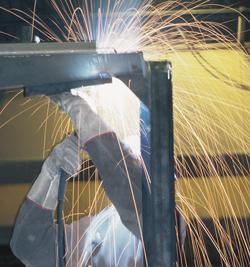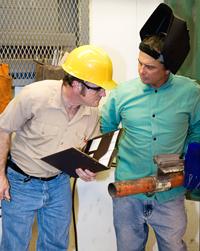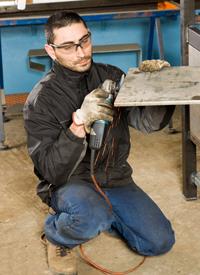- FMA
- The Fabricator
- FABTECH
- Canadian Metalworking
Categories
- Additive Manufacturing
- Aluminum Welding
- Arc Welding
- Assembly and Joining
- Automation and Robotics
- Bending and Forming
- Consumables
- Cutting and Weld Prep
- Electric Vehicles
- En Español
- Finishing
- Hydroforming
- Laser Cutting
- Laser Welding
- Machining
- Manufacturing Software
- Materials Handling
- Metals/Materials
- Oxyfuel Cutting
- Plasma Cutting
- Power Tools
- Punching and Other Holemaking
- Roll Forming
- Safety
- Sawing
- Shearing
- Shop Management
- Testing and Measuring
- Tube and Pipe Fabrication
- Tube and Pipe Production
- Waterjet Cutting
Industry Directory
Webcasts
Podcasts
FAB 40
Advertise
Subscribe
Account Login
Search
Getting to the bottom of lost welding productivity
17 preventable causes of arc-off time
- By Phil Evans, CWI
- November 8, 2011
- Article
- Arc Welding

Figure 1: Welding overhead is much more difficult than welding in position, and it takes longer. When a couple thousand feet of welds are being laid, that extra time adds up very quickly.
Welding efficiency has long been a concern to shop management. Downtime, or arc-off time, is a valuable indicator of production problems if it’s properly understood. Some models of welding equipment can log the amount of arc-on time per day, and simple math will reveal the total arc-off time.
The February 2011 issue of The FABRICATOR® included an article about a fabricating company that revamped its operations to allow welders to spend more time welding (“More arc-on, less arc-off,” p. 56). After more than 30 years in the field, I’d like to take that topic to the next level.
A few wasted minutes a day per person has a small price tag, but two or three hours a day per person can develop into an unacceptable year-end statement. Delays in production can affect profit dollars very seriously and cause unexpected delays in delivery.
Let’s take a shop floor look at 17 common—often preventable—reasons for excessive arc-off time.
1. Bathroom Breaks
A short bathroom break can easily turn into 15 or 20 minutes when a worker stops to chat with fellow employees about personal business. Added up, these breaks could consume an hour a day per employee.
2. Lack of Welder Preparation
Does the employee know what’s expected at the start of the shift? “Just weld that” is not the best directive to give an employee and could result in serious quality issues. The wait time for assignments can be relatively short, perhaps two to five minutes for each welder, but lack of planning on the part of the supervisor can delay welder assignments by 10 to 20 minutes per welder.
The welder needs to know what material he or she will be welding and if the material needs special attention or equipment. If so, that special equipment should be readily available.
3. Delayed Machine Setup
Can the welder set up his or her own machine, or is that the lead welder’s job? If the latter, make sure someone is there to set up the machine promptly.
By the time a lead setup person verifies the job requirements and makes the proper welding machine settings, 10 minutes per welder can be consumed. In a shop where welders produce code-dictated joints, most machines are locked in, and welding parameters are set already. This unlocking, setting, and relocking can increase the time that the welder is standing around waiting for the machine to be set up.
4. Poor Print Reading
If the welder cannot read prints and interpret symbols, he or she will have to wait for directions, probably 15 to 20 minutes, depending on how long it takes the supervisor to respond. Make sure the print details are clear and that the welder understands them.

Figure 2: Quality inspectors need to be nearby and ready to assist welders when they have completed a weld. They also should take an active role in all repairs to ensure the reworked parts meet the job specs.
5. Dirty Shop
Shop clutter, trash, and scrap steel can impede or block movement of equipment and people around the work area. Good housekeeping will result in less wasted time.
More important, however, is the fact that a cluttered shop can lead to safety problems. Hauling welding equipment over and around obstacles puts the operator and equipment at risk.
6. Unavailability of Material Handling Equipment
If material handling equipment, cranes, and forklifts are not readily available, the welder will have to wait. This could easily consume two to three hours a day for four or five welders.
7. Out-of-Position Welding
Welding in position (flat for groove welds, horizontal for fillet welds) versus vertical and overhead (see Figure 1) is a big issue when it comes to welding travel speed. It’s no surprise that in-position welding is two to three times faster and generally results in higher quality. A positioner costing a few hundred to several thousand dollars will pay for itself quickly if sized, bought, and used properly.
On the other hand, welding out of position requires 25 to 40 percent more time to weld that same joint in position.
8. Cylinder Changeout
What does it take to change out a cylinder for a full one? How far does the welder have to go to retrieve a full one? How much shop clutter, trash, cables, and hoses does the welder have to cross to get to the cylinder storage area? The round trip could easily take 15 to 20 minutes, sometimes up to a half hour.
9. Job Order and Print Changes
Has the work been stopped for changes to prints or the job order? If that’s the case, the welder may have to move everything to a new location until the new job order is executed to make room for other jobs to be worked on in that welding area.
Of course, when the new job order is ready, the welder will have to set up again before any arc is struck.
10. Rework and Repairs
Rework or repairs of defects and discontinuities not accepted by quality control or the customer are not productive labor. The cost of rework is at least twice the cost of the original fabrication; three times isn’t too uncommon. No repairs should be made until the problem has been evaluated, the cause determined, and the problem remedied.
11. Improper Wire Feeding
The most common problem in welding is improper wire feeding. Unfortunately, most welders don’t really understand wire feed issues. They just want to increase wire tension, but that won’t fix the problem.

Figure 3: As more welders are asked to take on postwelding activities, such as grinding, they need the right tools and workspace for the job. The faster they finish the cleanup, the sooner they can get back to welding.
Poor wire feeding can cost 10 to 20 minutes to clear and restart. It creates bad starts and stops, requiring grinding and excess contact tip changes. Above all, it frustrates the welder.
The wire feeder must be in good working order and have the correct drive roll tension. The less time the welder has to spend cleaning dirty drive rolls and clearing misfeeds, the better.
12. Bad Weather Conditions
Working in inclement weather, hot or cold, can take a toll on welders. AWS D1.1-2010, 5.12, requires ambient temperatures above 0 degrees F; surfaces free of ice, snow, and rain; and wind velocities less than 5 MPH.
Welders wear protective clothing not required by other trades, and working in temperatures over 100 degrees is not uncommon. Welders need to drink a lot of water in these conditions; quality and productivity will suffer if the welder is pushed beyond his physical limitations.
Air-cooled vests are available to reduce the welder’s body temperature on very hot days. However, these cooling vests may be an expense that either the employee or the employer is not interested in accruing.
What can employers do about inclement weather? Providing shelter is about the only thing. The simple truth is that weather extremes will affect weld time, and very little can be done about it.
What shouldn’t be done is pushing welders to increase their speed during these trying times. Quality is sure to suffer. Additional time for foul weather should be planned for to remain on schedule and on budget.
13. Slow Quality Control Inspection/Acceptance
Waiting for quality control (QC) inspection and acceptance can waste a welder’s time. QC employees provide support for production and should not hinder production unnecessarily. QC should be kept in the loop about production scheduling, and the inspectors should plan their day accordingly (see Figure 2).
14. Complex Weld Designs
Long, straight welds can be completed in a fraction of the time required for short, staggered, hard-to-reach, and multiple-contour welds.
15. Worker Overtime
Repeated overtime takes a toll. Regardless of the age of the worker, everyone needs a little rest on a regular basis. That recharge time is important. If work and deliveries are always behind schedule, perhaps the employees are running out of steam.
16. Old Equipment
Old and outdated welding equipment can seriously hamper production. It constantly breaks down, won’t hold settings, and the arc characteristics are poor and unstable. Cold lapping, poor bead shape, and variable weld penetration make old equipment undesirable.
17. Cell Phone Use
For some welders, the cell phone can consume an hour a day. Some have figured out ingenious ways to hide their phone use.
Other Reasons for Arc Breakage
During the workday, welders will break the arc for many other minor, normal reasons. Here are some ways arc-off time can be reduced or prevented:
- Clear tangled wire spools caused by improper handling and spooling problems.
- Clean out nozzle spatter.
- Replace contact tips and other gun front-end parts.
- Change position and reposition work platform and ladders.
- Reposition the part or workpiece.
- Change out damaged GMAW gun.
- Wipe the sweat that runs down and collects on the inside of the weld lens.
- Pull the feeder to position for access to the weld area.
- Chip and clean welds (see Figure 3).
Not all of these causes apply to all shops, of course. But when there is a slowdown in planned production, the stumbling blocks that welders encounter on the shop floor need to be investigated and efforts made to eliminate as much frustration as possible.
About the Author
Phil Evans, CWI
218 Deerfield Lane
Pulaski, TN 38478
913-292-6017
subscribe now

The Fabricator is North America's leading magazine for the metal forming and fabricating industry. The magazine delivers the news, technical articles, and case histories that enable fabricators to do their jobs more efficiently. The Fabricator has served the industry since 1970.
start your free subscription- Stay connected from anywhere

Easily access valuable industry resources now with full access to the digital edition of The Fabricator.

Easily access valuable industry resources now with full access to the digital edition of The Welder.

Easily access valuable industry resources now with full access to the digital edition of The Tube and Pipe Journal.
- Podcasting
- Podcast:
- The Fabricator Podcast
- Published:
- 04/16/2024
- Running Time:
- 63:29
In this episode of The Fabricator Podcast, Caleb Chamberlain, co-founder and CEO of OSH Cut, discusses his company’s...
- Industry Events
16th Annual Safety Conference
- April 30 - May 1, 2024
- Elgin,
Pipe and Tube Conference
- May 21 - 22, 2024
- Omaha, NE
World-Class Roll Forming Workshop
- June 5 - 6, 2024
- Louisville, KY
Advanced Laser Application Workshop
- June 25 - 27, 2024
- Novi, MI































